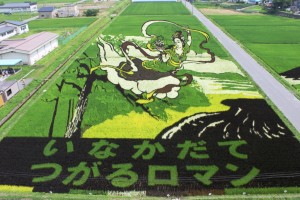Japan Local: Inakadate Rice Field Art
Mel T (Aomori-ken, 2007-2012) is a Canadian living and working in Towada City, Aomori. For more information about events, sightseeing, restaurants, etc. in Towada City, and around Aomori Prefecture & Japan, visit her blog at http://towada-city.blogspot.com.
Inakadate Village (Aomori Prefecture) has a long history relating to rice. The site of an ancient rice field dating back to the mid-Yayoi Period (300 B.C.~300 A.D.), the Tareyanagi Iseki was discovered in Inakadate in 1981. This was a significant find as until its discovery, it had been believed that rice fields were not cultivated in Tohoku during the Yayoi Period. The Tareyanagi Iseki was designated a National Historic Site on April 11, 2000.
To celebrate and promote its history of rice production, Inakadate began offering rice planting experience tours. In order to make the experience more interesting, they decided to use different coloured rices to draw a picture of Mt. Iwaki with the words 弥生の里いなかだて (Yayoi no sato Inakadate) meaning “Yayoi Village Inakadate.” This was the humble beginning of rice field art–although at the time it was not referred to as “art” but simply as “rice characters” (稲文字 ine moji).
Since its beginnings as “rice characters,” the drastic improvement in technological and artistic levels have made Inakadate’s rice art an increasingly popular site for both domestic and international tourists. It has proved so popular that in 2012, a second rice field art site was started at the Michi no Eki (Roadside Station) Inakadate “Yayoi no Sato.”
The theme for 2015’s rice field art is “Gone with the Wind” for the main site and “Star Wars” for the second site (Michi no Eki Inakadate “Yayoi no Sato”).



Comments are closed.